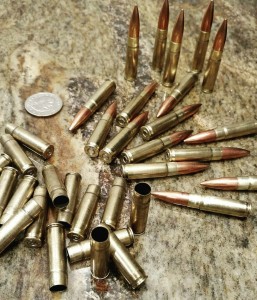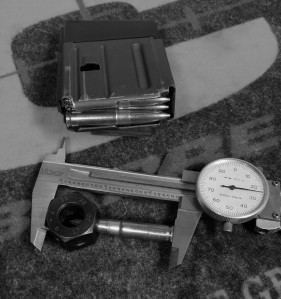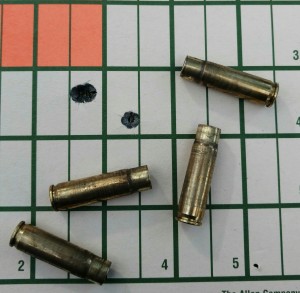300 BlackOut
The first post on the 300 BlackOut described the cartridge and development. Since then I have spent some time at the reloading bench and range getting to know the round. Depending on your shooting desires you may opt to use factory ammo and be happy with the results, as for hand loaders we are intrigued to experiment with components seeking the sweet spot of a cartridge/rifle combination. Most articles will talk about light Supersonic velocity rounds or heavy Subsonic’s, with not much talk about the middle weights (168grain to be specific) bullets. I choose to load with the 168’s for reasons of proving they will shoot sub-moa groups at 100 yards all while starting out at Supersonic velocities then after the transonic region maintaining Subsonic velocities well into the 550+ yard range.
Another topic I will discuss will deal with tuning the AR15 upper barrel nut torque and clocking the flash hider if used. Tuning a specific load to best match barrel nodes of vibration will produce good results if you have the patience and proper tools to test various combinations.
I started load work with a Leatherwood CMR 1-4×28 optic then switched to a Cabela’s 4-18×50 for more magnification.
***LOADS LISTED SHOULD BE REDUCED BY 10% FOR USE OTHER THAN IN THIS TEST RIFLE****
Starting off at the reloading bench with quality prepped brass is critical with any loading process. You might convert military brass from 5.56 to 300BLK or use commercially manufactured brass (do not mix the two as brass wall thickness will differ and case pressure will change). I deburr the flash holes, file trim cases and F.L. resize, most reloading books will list H110 and AA1680 as the go to powders and I started off with a H110 equivalent powder (W296). With an AR15 platform I seated bullets out to max magazine length to start with and once a good powder charge was found then the bullets were seated deeper by .05” increments to test accuracy. 168 grain hollow point boat tail bullets were selected and a Lee factory crimp die set to a medium crimp this held the cartridge overall length without set back after repeated chambering. I really wanted W296 to be “the powder” for this rifle and some groups would print a nice clusters at ½” centers while others would open to +1”. 15 grains of W296 produced the best accuracy sometimes and that proved to me it was time to run some data thru Quick Loads to compare other powder.

 W296 powder would not group consistent enough at 100 yards.
W296 powder would not group consistent enough at 100 yards.
I won’t go into all the ranges of powder I tried while looking for the sweet spot charge, and while in the Quick Load program crunching numbers with IMR 4227 I noticed predicted velocities were a bit slower than with W296. At 50 fps slower velocities the IMR 4227 had a better node of vibration for bullet muzzle exit so test loads were built up and groups were evaluated. CBC Industries built the AR upper equipped with a free float hand guard, flash hider and heavy 16” barrel, the workmanship was excellent and trouble-free function. However occasional first and last round flyers would crop up and that just frustrated me as I spend careful time building ammo as precise as I can. I settled on 14.8 grains of IMR 4227 with 168 grain HPBT bullets tucked inside Lake City converted brass and ignited with CCI400 primers, I ended up dropping down to 14.6 grains and really shrunk the groups as you will see in the below photos. While scrubbing out the carbon and copper from the barrel I remembered an article printed in a tech magazine talking about tuning an AR15 barrel nut torque for accuracy. The theory is that more or less torque applied to the barrel nut will adversely affect barrel vibration when a cartridge is fired. This was very interesting as military match rifles cannot be modified for competition “as issue” configuration is the rule, tuning the barrel nut is not modifying the rifle.
Range tuning the AR is not a quick process especially with optics mounted, the process goes as follows.
- Use proven accurate loads
- Shoot a group and note size and barrel nut torque
- Strip upper for clamping in clamshell fixture in vise
- Note current barrel nut torque
- Adjust more or less torque to nut and note FT. Lbs
- Assemble
- Shoot anther group
- Repeat
- Note when groups became smaller or bigger
After adjusting the nut torque it will become evident whether you need more or less torque as group size will dictate FT. Lbs. as a note 35 FT. Lbs is the minimum I would torque a barrel nut to without a thread locking agent. I found the nut torque to be at 80 FT. Lbs. on the factory assembled upper and after the tuning process I settled on 35 FT. Lbs. Another interesting point the author made was indexing a flash hider with a solid bottom section. As with an “as issue” match rifle slight clocking of the flash hider is not a noticeable item, and yes it will fine tune a load to some degree. I found between 1 O-clock and 3 O-clock will be enough indexing to tune a good load. If you hit the barrel nut torque with vibration node spot on you won’t notice much improvement with indexing the flash hider.
Typical 100 yard groups shot with a 300 BlackOut and 168’s at supersonic velocity when you find the right powder, in this case it was IMR4227 @ 14.6 grains
yes I pulled the fourth shot on the right hand target.
Load development with several components 
Measuring to the ogive for consistent seating depth 
The Transonic region:
Flight thru the Transonic region results in bullet yaw becoming unstable thus affecting trajectory and accuracy. The idea is to set the distance at which bullets go thru the Transonic region as maximum distance. From the muzzle downrange the bullet loses its initial speed due to drag and reaches the “Transonic region” when the speed hits Mach 1.2. Continuing on it crosses the sound barrier at Mach 1, exiting from the Transonic region when its speed falls below Mach 0.8. In the case of the 168’s loaded in a 300 BlackOut as can be seen in the table, 500 yards would be maximum range (1,125 fps is aprox. bottom of Subsonic velocity)
Yards Velocity Energy
100 1558 905
200 1428 760
500 1129 475 exiting Supersonic
——–Transonic Region——-
800 970 351 Subsonic region
1000 901 303
Elevation 662, Pressure 2944, Temperature 45F
As with any drop chart corrections in elevation will be needed to assure hits. This chart also shows good Subsonic velocity out to 1000 yards.
Supersonic bullets need to be stable for accurate flight and Subsonic bullets alike, a term often used regarding stable bullet yaw is to “go to sleep“. The theory is to get the bullet to go to sleep as quickly as possible thus taking advantage of a better trajectory. The Transonic region will disturb this sleep and then hopefully regain stable flight once in the Subsonic region. Most Subsonic loaded ammo start out at less than 1000 fps thus running out of velocity and energy sooner. Only experimenting at longer ranges will prove the ability of a load to perform good out to the Subsonic region, the idea I am toying with is to shoot a mid-weight bullet at Supersonic speed thru the sleep stage and hopefully send it back to sleep way out in the Subsonic region. With winter here in Michigan I will be able to stretch out my shooting distance at the range in hope of sending these 168’s to sleep.
This is a sneak peek of the optics I will be reviewing soon!
 ATN X-Sight II HD 3-14 scope. 1080 p video, wi-fi, geo tracking, day/night vision and ballistic shooting solution system.
ATN X-Sight II HD 3-14 scope. 1080 p video, wi-fi, geo tracking, day/night vision and ballistic shooting solution system.
It’s December and Christmas is upon us. Get out and enjoy time with family and friends celebrating the birth of our Savior Jesus Christ. While others are drinking eggnog and watching the game on the flat screen try to sneak out and send some bullets to sleep.
Right On Dead On All The Time





